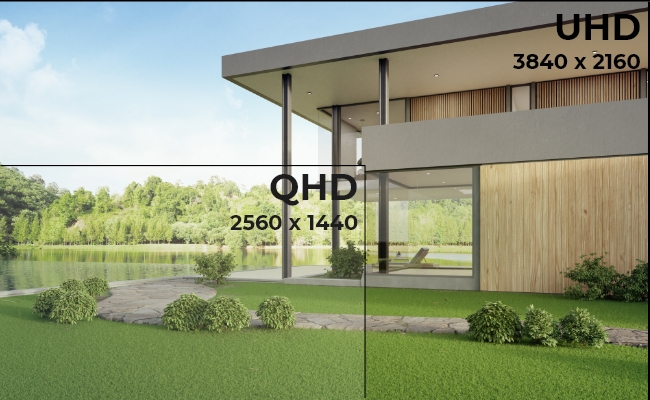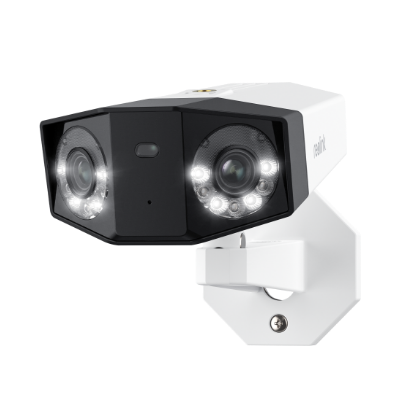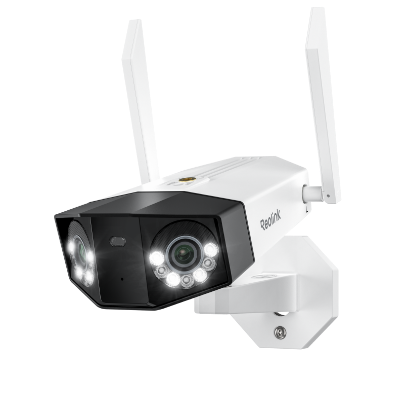UHD vs. QHD: Understanding Their Differences

When buying a monitor, TV, or security camera, the most confusing terms are UHD, QHD, and FHD, especially for those who are non-tech-savvy and beginners.
In this article, we will have a deeper look at UHD vs QHD. We will explain these terms, their resolution, and how they affect the image quality. After reading this quick guide, you can pick the right screen for your needs.
What is QHD?
QHD stands for Quad High Definition, and it is often referred to as 2K/1440p.
The QHD resolution is 2560 x 1440, which translates to 2560 pixels in each row and 1440 pixels in each column.
Thus, the total number of pixels in QHD is 3,686,400, which is four times more than the standard HD 720p.
QHD is an incredible option for someone who wants to upgrade from 1080p resolution. It offers better details, colors, and crispier images. It supports a wide range of graphics cards, even the older one you might have, so it could be a good option for an upgrade. Moreover, it is budget-friendly and a bang for every buck.
What is UHD?
UHD means ultra-high definition, which is also called 4k/2160p.
Its resolution is 3840 x 2160, so there are 3840 pixels horizontally and 2160 vertically. Such a display would have a total number of 8,294,400 pixels, which is a bit more than 8 million pixels.
UHD is a premium display resolution that uncovers tiny bits of details and offers an immersive visual experience. For those who can't compromise on the quality of video/image, this could be a great choice. However, it is way more expensive than having a QHD screen.
UHD vs QHD: What's the Difference?
The primary difference between QHD and UHD is the resolution. The resolution of UHD is 3840 x 2160, while the resolution of QHD is 2560 x 1440. That's a difference of 2.25X. So, in terms of details and image quality, UHD is way better than QHD.
Here is a list of their differences:
UHD vs QHD: How to Choose?
High resolution is not always the perfect solution for your needs. Sometimes, it becomes an unnecessary investment. But in some cases, it is a necessity. Thus, it depends on the usage, and you have to make a decision accordingly.
QHD vs. UHD monitor
For normal office work or home computers, QHR monitors are more than enough. They give clear details, immersive graphics, and top-notch image quality. Secondly, you can go with your existing system to enjoy the rated resolution of the monitor.
But if your job is graphics designing, video editing, fast processing, or something similar, your best option would be a UHD monitor. It is a long-term investment, and you can relax for several years and even a decade.
QHD vs. UHD for gaming
For professional gamers, UHD would be the perfect option. It will offer incredible details due to high resolution and mesmerizing colors and visuals. Playing games on a UHD screen is a next-level experience.
But to play games at this resolution, you need a high-end PC with high processing and a top-tier graphics card. Secondly, the game should support such high resolution. If these are not possible, then investing in a UHD screen would be useless.
QHD is a budget-friendly alternative for gamers. It is one of the most preferred resolutions because of its immersive display, high compatibility, and low cost.
Moreover, higher resolution also comes with a compromise on the speed of gaming. Thus, if you need the right balance between speed and graphics quality, QHD is the best option.
QHD vs. UHD for security camera
QHD and UHD cameras are good options for home security. If you want to keep an eye on a small area, such as a room, door front, or garage, QHD is more than enough. It will offer you optimal quality and every detail you need.
But if you want to cover a large area, such as a large swimming pool and backyard, it is better to go with a high-resolution camera. It will offer you a clearer visual experience, and you can even zoom into the number plates of vehicles.
You should also consider the security camera's data consumption, bandwidth requirement, and compatibility before buying one. QHD cameras require less bandwidth, and they consume less data. Therefore, they are faster in transmitting live previews. And they are compatible with a wide range of NVRs.
On the other hand, UHD offers incredible video experiences, but at the same, it consumes too much data. It requires a significant bandwidth to offer a smooth live video experience. You need the latest NVRs to run UHD cameras and have optimal video quality.
FHD vs QHD vs UHD: Which is Better?
Let's talk about the resolution first because that is the primary difference and the most important thing to understand: FHD vs QHD vs UHD.
- FHD = 1920 x 1080 = 2,073,600 pixels
- QHD = 2560 x 1440 = 3,686,400 pixels
- UHD = 3840 x 2160 = 8,294,400 pixels
By looking at the resolution, you can clearly understand which provides better details and an immersive visual experience.
In short, we can say UHD > QHD > FHD.
However, you don't need to decide on the resolution. Also, consider your usage, the drawbacks of high resolution, budget, and other factors in mind.
FHD is the most budget-friendly option here. For common office usage and normal tasks that are not related to graphics, FHD could be the first choice. It is fast, affordable, and super-compatible.
UHD is the best among all because of the pixels it contains. For a memorable visual experience, nothing can be better than this. However, it comes at a heavy cost and reduces the speed. You need a high-performing PC to enjoy high resolutions.
Out of these three, the balanced mix of resolution, visual experience, cost, and speed is QHD. It can satisfy almost all needs, whether gaming, graphics designing, video editing, office work, or anything else.
Higher Resolution Than UHD - 16MP Security Camera
A 16MP resolution means a digital image contains 16 million pixels. More megapixels translate to greater detail and the ability to print larger pictures without losing quality.
A 16MP camera is excellent for capturing intricate details, resulting in clear and sharp video footage. Reolink already offers a complete lineup of 16MP security cameras. The Duo 3 PoE utilizes Power over Ethernet (PoE) technology, enabling the camera to receive power and an internet connection through a single Ethernet cable.
Groundbreaking 16MP Dual-Lens PoE Camera
16MP UHD, Dual-Lens, Motion Track, 180° Wide Viewing Angle, Power over Ethernet, Color Night Vision.
Now, with the launch of the Duo 3 WiFi, Reolink has incorporated WiFi cameras into this lineup. Both cameras feature 16MP ultra-high resolution and dual lenses, providing a wide 180-degree field of view.
Groundbreaking 16MP Dual-Lens WiFi Camera
16MP UHD, Dual-Lens, Motion Track, 180° Wide Viewing Angle, Plug-In WiFi, Color Night Vision.
FAQs
1. Is UHD better than QHD?
In terms of resolution, UHD is undoubtedly better than QHD. It has more pixels in an area unit, so there will be more details. However, the choice depends on the usage of the person. Sometimes, QHD is more than enough to satisfy the needs and is a good investment.
2. Is UHD better than QHD for gaming laptops?
UHD is definitely better in terms of video quality and immersive experience. But when you enjoy gaming at a very high resolution, the speed or refresh rate is compromised. Thus, you might not have a very smooth gaming experience in UHD. On the other hand, QHD offers a bit less resolution but still a good visual experience. It is definitely a good option for quality and smooth gaming.
3. Is there a big difference between HD and QHD?
If you are experiencing HD and QHD on large screens, you will feel a significant difference. QHD offers sharper images and is way better than HD. Even on small screens like smartphones, you will feel a difference between these two resolutions.
Conclusion
A better understanding of UHD vs. QHD is essential when you need to conclude while selecting an IP camera, monitor, or TV. Both these are great options for immersive visual experience; however, they differ in resolution, cost, speed, and compatibility. According to your usage and needs, you can pick the best one that can offer the best value for the money.
Search
Subscribe for the Latest Updates
Security insights & offers right into your inbox


